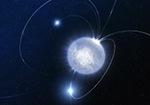Nature: new understanding of star death

Credit: ESO/L.Calçada
An international team led by astronomers at Queen’s University Belfast have shed new light on the rarest and brightest exploding stars ever discovered in the universe.
"I think that the most important outcome of this study is that it unifies two different sub-classes of super-luminous supernovae. The first spectra that we obtained at the Nordic Optical Telescope suggested a similarity with another class of luminous events. However, later evolution showed that these objects turned out identical to the rarest class of super-luminous supernovae. For these events a rather exotic explosion mechanism had been proposed. But it is likely that we are looking at two different faces of the same phenomenon!
Giorgos Leloudas
DARK Affiliated Scientist Giorgos Leloudas (Oskar Klein Center) was among the group of international scientists working on the results.
The research is published in the journal Nature. It proposes that the most luminous supernovae – exploding stars – are powered by small and incredibly dense neutron stars, with gigantic magnetic fields that spin hundreds of times a second.
An explanation that had been proposed in the past about these spectacular explosions was that they might represent the long-sought "pair-instability" explosion mechanism and that they involved the explosion of a super-massive star. The new findings suggest that their origins may be better explained by a type of explosion within the star’s core which creates a smaller but extremely dense and rapidly spinning magnetic star.
The full article is available on Nature’s website and arXiv.org:
